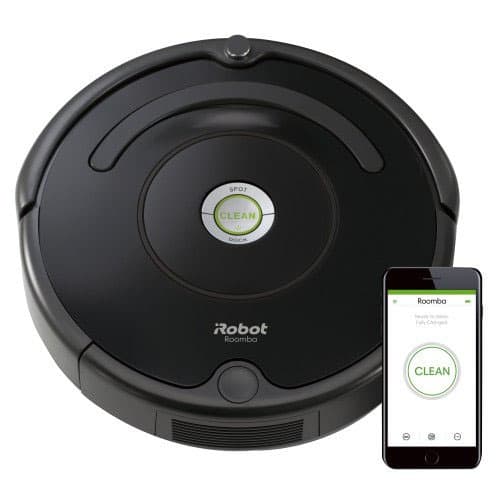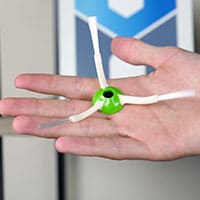If you’re targeting your focus on the upper-echelon Roombas, it’s likely that the i7, i7+, S9, or S9+ have caught your eye. So what makes these Roombas so special and how are they different from each other?
Let’s hit the highlights right now in our 4-way head-to-head: Roomba i7 vs S9 vs i7+ vs S9+
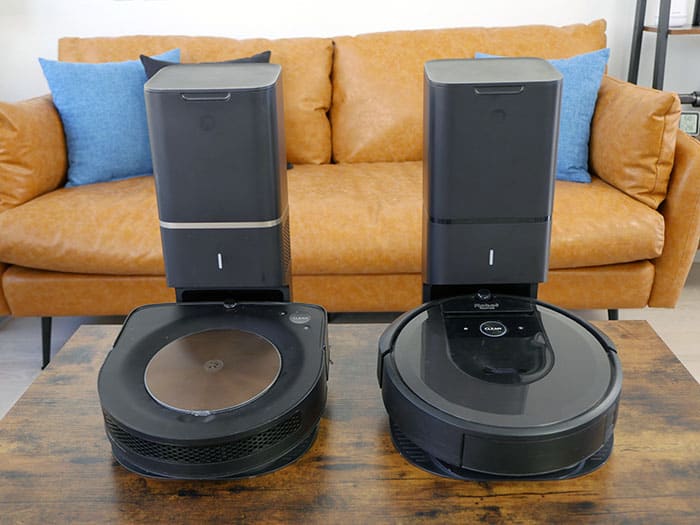
The chart below is a full comparison of the Roomba i7 vs. S9 vs. i7+ vs S9+.

- Cleaning: 99%
- Runs: 75 mins.
- Recharge & Resume? Yes
- Smart Maps: Yes
- Empties bin? Yes
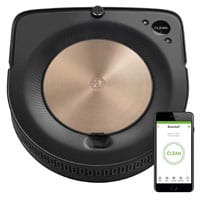
- Cleaning: 99%
- Runs: 75 mins.
- Recharge & Resume? Yes
- Smart Maps: Yes
- Empties bin? No
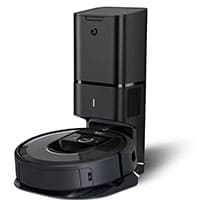
- Cleaning: 99%
- Runs: 75 mins.
- Recharge & Resume? Yes
- Smart Maps: Yes
- Empties bin? Yes
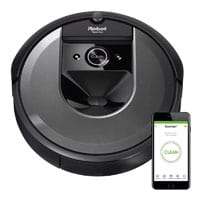
- Cleaning: 99%
- Runs: 75 mins.
- Recharge & Resume? Yes
- Smart Maps: Yes
- Empties bin? No
Roomba i7 vs i7+ vs S9 vs. S9+: What’s the Same?
There’s a lot of features that are similar between these four Roombas so before reviewing the differences, let’s touch on the major features that are the same.
- Cleaning Performance: All four of these Roombas have excellent cleaning performance, between 99-100% on all three floor types we tested on—hardwoods, low pile carpet, and high pile carpet.
- Long Run Time: These Roombas also all have up to a 75 minute run time with extended lengths with Recharge & Resume. Basically, these are designed to just keep going until the job is done. With two Recharge & Resume cycles, that’s up to 225 minutes of total run time.
- Compact, High-efficiency Filter: All of these Roombas also use the same high-efficiency filter that was first launched with the i Series. It’s less than half the size of previous Roomba filters (ie: AeroVac or AeroForce), which allows for a larger on-board dust bin and less room required for bulky filtration systems.
- Optional Self-Emptying Dust Bin: Both the i7 and the S9 come in standard versions and Plus versions (the i7+ and the S9+). The Plus versions come with a self-emptying dust bin which holds up to 60 loads of debris from the on-board dust bin.
- App Control: These four Roombas also offer app control, which allows you to easily
- Advanced Navigation: VSLAM navigation technology on the i7 & i7+ and S9 & S9+ is the most advanced that Roombas has to offer to date. It can detect obstacles and navigate in straighter paths than less advanced Roombas (ie: iAdapt 1.0 or iAdapt 2.0).
- Imprint Smart Mapping: This technology allows any of these four Roombas to intelligently map a space, establish zones, and create generally smarter cleaning cycles. In addition, these Roombas can also sync up to the Braava m6 mopping robot (also by iRobot ) for a 2-part cleaning cycle where the Roomba automatically vacuums and then automatically mops the space right after.
So that’s a pretty exhaustive list of similarities. With everything that is the same, what’s different about these models?
Let’s hit the highlighted differences between each of these Roombas.
Roomba i7 vs. i7+ Differences
DIFFERENCE: the dust bin (larger capacity with manual emptying required vs. slightly smaller onboard capacity with self-emptying technology)
The dust bin on the Roomba i7+ comes with the Clean Base charging station meaning that it can empty the on-board dust bin directly into the larger dust bin at the dock.

The standard Roomba i7 does not have this feature and you’ll need to manually empty the on-board dust bin as it fills up.
For future expansion planning, I do want to add that the Roomba i7 is compatible with the Clean Base so you can convert the i7 to the self-emptying system at a later date if you decide to go that route.
Roomba S9 vs. S9+ Differneces
DIFFERENCE: the dust bin (larger capacity with manual emptying required vs. slightly smaller onboard capacity with self-emptying technology)
Similar to the i7, the S9 does not have the self-emptying dust bin and the Roomba S9+ does.
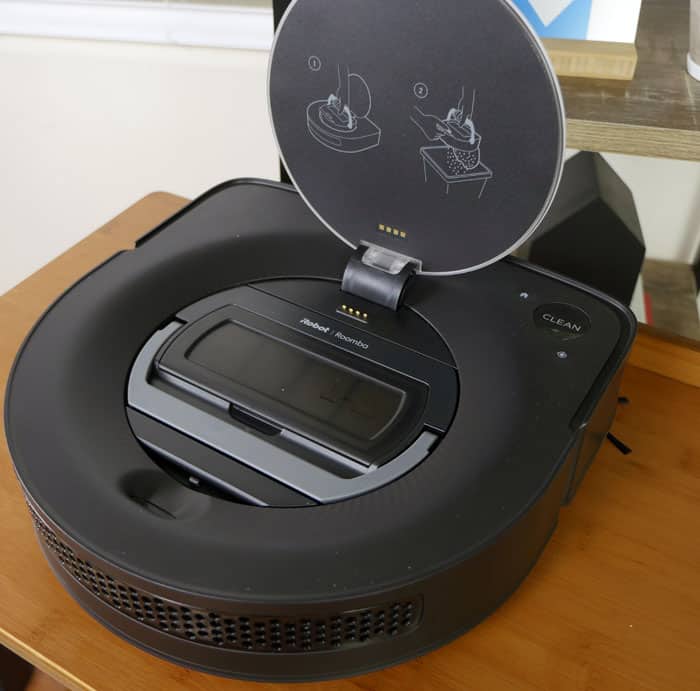
The Clean Base can hold debris from the on-board dust bin for up to 60 days, allowing you to clean for longer without stopping to worry about emptying the bin.
Roomba i7 vs. S9 Differences
DIFFERENCE: body style, cleaning path, suction power, spinning brush
Roomba i7

Roomba S9

The Roomba i7 and Roomba S9 have a longer list of differences that separate the two models.
Here is a complete list below:
- Body Style: The Roomba S9 has a D-shaped body while the Roomba i7 has the standard round Roomba body style.
- Cleaning Path: The difference in body style also allows for the S9 to have a wider cleaning path and wider central brushroll.
- Suction Power: The Roomba S9 has 40X the suction power (compared to the Roomba 600 series), while the Roomba i7 has only 10X the suction power. Despite this difference in specification, I will say that the extra suction didn’t prove to make any noticeable difference in actual cleaning performance.
- Spinning Brush: The spinning brush on the S9 is located right at the corner and is designed specifically for cleaning corners, with shorter bristles. The spinning brush on the i7 has longer bristles to help capture more debris and pull it into the cleaning path of the central brushroll.
Roomba i7+ vs S9+ Differences
DIFFERENCE: body style, cleaning path, suction power, spinning brush
Similar to the specs mentioned above, the i7+ vs S9+ have the same differences. One similarity that they have (not included on the standard i7 or S9) is that both of these Roombas come with the self-emptying Clean Base.
Quick Picks
If you’re looking for the lowest price, but similar cleaning performance, the Roomba i7 is the best choice.
This particular model lacks the self-emptying dust bin and has a smaller cleaning path (overall), but it performed exceptionally well in our cleaning tests and does have intelligent navigation and digital smart mapping.

Overall, the i7 is a great option with budgets in mind.
If you want the best of the best, the Roomba S9+ checks all the boxes that many users are looking for in an ultra-high-end robot vacuum. It has the self-emptying dust bin, most advanced navigation, digital mapping, and app control.
If you don’t want to miss out on any special features, the S9+ is a great Roomba with a user-friendly interface and fantastic performance.
How We Recommend & Test
To fully assess the performance of any of the robot vacuums we review, we put it through the same in-house testing process.
We test each vacuum by setting it against our testing lane, complete with four different debris type and three different flooring types.
We test on hardwood floors, low pile carpet, and high pile carpet. For debris types, we sprinkle cereal, kitty litter, rice, and cereal. This variety of sizes and densities used in these tests helps to provide a clearer picture of the types of debris or flooring each vacuum may struggle with.
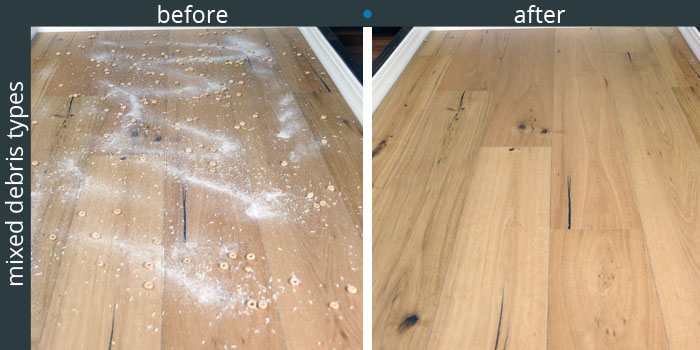
Below, you can find the full cleaning results of each of the Roombas we tested here.
Clarifying note – the robot unit included on both the i7 and i7+ is exactly the same. The same is true for the S9 and S9+.
The difference between these models is the self-emptying dust bin, which would not impact performance for this cleaning test, as the robot vacuum itself is exactly the same.
Additional Tests
In addition to our raw cleaning tests, we also test the navigation, app, clean base (if applicable), maintenance, and other important features. Ultimately, we try to use the robot the same as any user would, putting it through a real-world trial.
Cleaning Performance
Regarding cleaning performance, the i7, i7+, S9, and S9+ are nearly identical.
Roomba i7 & i7+
Overall
99%
Hardwoods
99%
Low Carpet
99%
High Carpet
99%
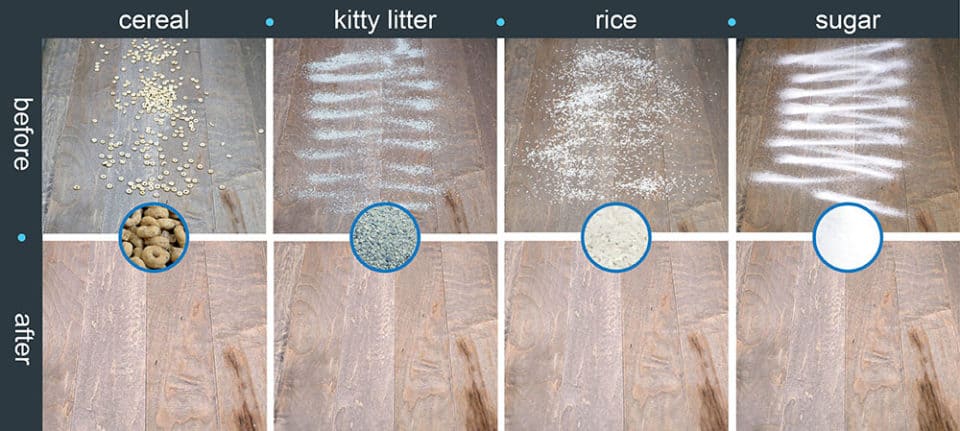
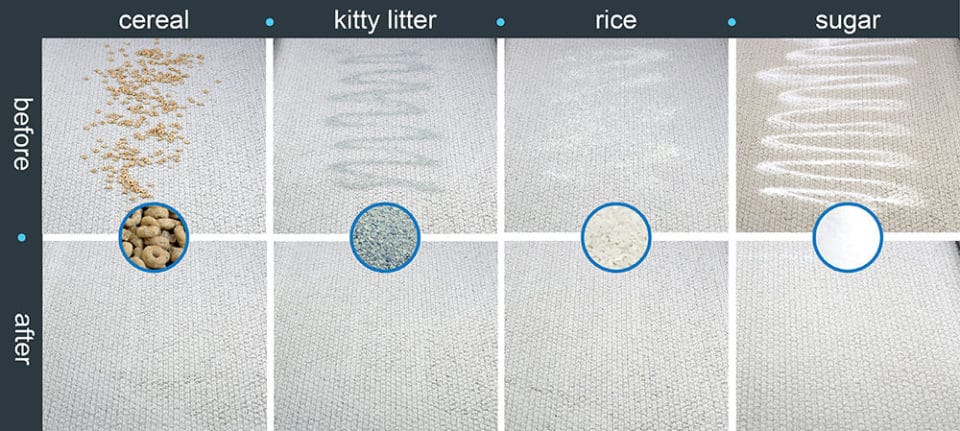
Roomba S9 & S9+
Overall
99%
Hardwoods
99%
Low Carpet
99%
High Carpet
99%

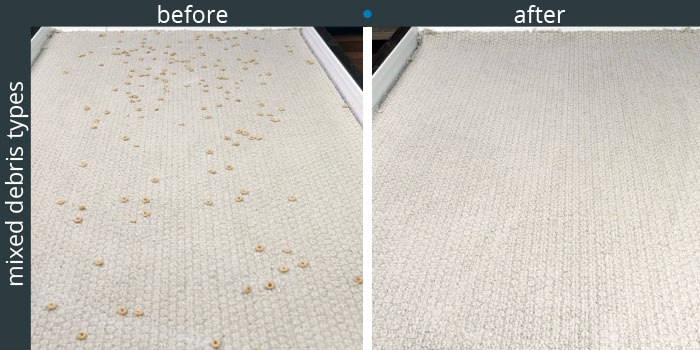
Which has more suction power?
The Roomba S9 and S9+ have greater suction power (40x that of the Roomba 600 Series) compared to the Roomba i7 and i7+ (10x that of the Roomba 600).
Despite this relatively big jump in suction power, when we tested the cleaning performance of both of these models, we didn’t really notice any huge differences in actual cleaning performance.
Debris Removed: S9 & S9+
99%
Debris Removed: i7 & i7+
99%
Both models cleaned 99% of debris from our tests, which is incredibly uncommon. Only 5 robots we’ve tested in the last 3.5 years (and counting) have achieved a 99% (out of 50+ models).
The Design
The design of the Roomba i7, i7+, S9, and S9+ is basically identical among each primary model, with slight underside variations between the regular and plus (+) versions.
The Roomba i7 and i7+ tend to take after preceding Roombas. It has the classic round body, similar controls, and an underside that feels really similar to what we’ve seen in the past from Roomba.
The Roomba S9 and S9+ feel quite different. It uses a D-shaped body, redesigned controls and usability features, as well as some big changes under the hood.
Roomba S9 vs. i7: How do they look?
The Roomba S9 and S9+ have a D-shaped body with copper accents, while the Roomba i7 and i7+ have a classic round body with primarily black body.
Roomba S9 & S9+

Roomba i7 & i7+

How is the S9 brushroll different from the i7?
The D-shaped body of the S9 allows for a much wider brushroll than the brushroll on the i7 and relocates it to the front of the vacuum.
With the wider brushroll also comes:
- Faster cleaning performance
- Improved edge cleaning
Roomba S9+

Roomba i7+

The D shape allows the S9 to sweep closer along edges with more precision. There is a small, 5-arm spinning brush on one side, which pulls debris into the path of the brushroll.
For comparison, the Roomba i7 uses a similar spinning brush (but with longer bristles and only 3 arms) to pull debris into the path of the brushroll.
On the i7 & i7+, the distance between the brushroll and the spinning brush is greater, which does make it a little extra work to get the debris into the dust bin.
Size & Dimensions
Between these four models, there are two different vacuum sizes and two different base sizes. Each Roomba can be paired with either charging base.
Roomba S9 & S9+
- 12.25″ wide
- 3.5″ tall
Roomba i7 & i7+
- 13.3″ wide
- 3.6″ tall
Clean Base
(with i7+ and S9+ only)
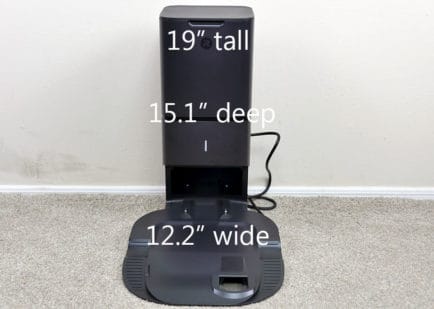
- 19″ tall
- 15.1″ deep
- 12.2″ wide
Standard Base
(with i7 and S9 only)

- 4″ tall
- 5.5″ deep
- 5″ wide
The S9+ and i7+ use the Clean Base charger.
The S9 and i7 use the standard Roomba charger.
Accessories
Here are the complete accessory lists for each Roomba model compared in this guide.
Roomba i7
- Standard charger
- Virtual wall x 1
- Filter x 2
- Spinning brush x 2
Roomba i7+
- Clean Base charger
- Disposal bags x 2
- Virtual wall x 1
- Filter x 2
- Spinning brush x 2
Roomba S9
- Standard charger
- Virtual wall x 1
- Filter x 2
- Spinning brush x 2
Roomba S9+
- Clean Base charger
- Disposal bags x 2
- Virtual wall x 1
- Filter x 2
- Spinning brush x 2
As you can see, the regular and plus models are nearly identical, with the exception of the Clean Base.
Usability
The usability of these Roomba is similar, but not identical.
Here’s what you need to know.
User-friendly features of all four of these models includes:
- App Control: pair with the iRobot Home app for simple, smartphone control
- iRobot Genius: a new adaptation within the app, but one that makes responsive suggestions for your Roomba, like event-based automation or recommended cleaning zones
- Imprint Smart Mapping: allows you to pair the Roomba vacs with iRobot Braava mopping robots for consecutive cleaning cycles
- Digital Maps / Zoned Cleaning: develops digital maps (in-app) that can be used to set up a virtual boundary, prioritize zoned cleanings, or schedule specific areas to be cleaned more or less often
- Long Run Time: run time up to 75 minutes per each cycle as well Recharge & Resume
User-friendly features of just the Roomba S9+ or Roomba i7+ include:
- Self-Emptying Clean Base: holds up to 60 loads of debris from the on-board dust bin; as a cycle completes, the Roomba will automatically deposit the debris into the Clean Base and go back for more cleaning until the job is done
NOTE: The Roomba i7 and S9 do not come with the Clean Base, but they are compatible with the self-emptying system and it can be purchased separately. If you decide to go this route you’ll just need to swap out the dust bin and the charging station.
Maintenance
Keeping up with maintenance tasks is an important part of maintaining peak performance with any robot vacuum.
The maintenance tasks for all 4 of these vacuums can be divided into two groups: i7 / S9 vs. i7+ / S9+.
i7 / S9 Maintenance
- Clean filter regularly
- Empty on-board dust bin
- Clean brushroll, as needed
- Replace battery, as needed
i7+ / S9+ Maintenance
- Clean filter regularly
- Empty or replace CleanBase debris bag, every 60 days
- Clean brushroll, as needed
- Replace battery, as needed
The debris bags for the Clean Base are technically disposable, but also they’re pretty high quality as well. It would be easy to simply empty the debris and reuse the bag as needed (if you wanted to save a buck).
Clean Base Debris Bag

Debris Bag Installed

Washable Dust Bin
All four Roombas have a washable dust bin that can be washed and rinsed with mild soap and cool water. Be sure to let it air dry completely before reinstalling.

Filter & Dust Bin Access
The way in which users access the filter is another difference between the S9 and i7 Roombas.
Roomba S9+

Roomba i7+

The i7+ uses the traditional method of pulling out the dust bin from the side of the vacuum. When you do that, you can then access the filter within the dust bin.
On the S9, it’s a bit more streamlined and uses a flip-up top to expose the bin. This method is similar to what we’ve seen from Roborock, an overseas competitor to the Roomba lineup.
MORE: Roborock vs. Roomba
Which Roomba is the better value?
So if you’re looking at value alone, which Roomba is the best bang for your buck? Well, a lot of the answer depends on what you put value in.

If you value your money more, the Roomba i7 will likely check all of your boxes. It skips the self-emptying dust bin and uses the classic round body style, but still has fantastic suction power, run time, cleaning performance, and usability.

If you value your time, the Roomba S9+ may be the better choice. This vacuum comes with a self-emptying dust bin which means less time emptying debris from your Roomba. It also has a wider brushroll with an improved located which increases the accuracy of debris clean-up the first time and also has faster cleaning performance.
Which Roomba should you buy?
I would recommend either the S9+ or the i7+ if you’re looking for a Roomba with a self-emptying dust bin. This is the main separating difference between the standard and plus versions of these Roombas.
If you don’t need this feature and want to save some cash I would recommend the standard versions of either of these Roombas.
I would recommend the Roomba i7 if you’re looking for:
- A lower sticker price: Between these four models, the i7 is the least expensive in the bunch. It lacks the self-emptying dust bin but still has excellent cleaning performance, a long run time, and smart digital mapping, app control, and zoned cleaning cycles.
- Smart Control: As upgrades over the Roomba 900 Series, the Roomba e5 and the Roomba i3, the Roomba i7 is the first Roomba to offer zoned cleaning cycles (in-app). It is compatible with Amazon Alexa for voice controls, comes with the iRobot Genius event-based automation technology, and you can schedule cleanings (whole home or specific rooms) to meet your custom needs.
- Click here to read the full review for the Roomba i7 & i7+.
- Click here to check the price for the Roomba i7 & i7+.
I would recommend the Roomba S9 if you’re looking for:
- Shorter cleaning cycles: The D-Shaped body of the S9 uses a wider brushroll and locates said roll at the front of the vacuum for improved cleaning performance and shorter cycle run times.
- Greatest suction: If suction is a top priority, the S9 has the strongest suction of any Roomba to date. While Roomba doesn’t disclose the exact power, we do know that it’s 40x times the max suction of the Roomba 600 series.

